March Calendar
Tuesday, 3-5 Master Gardener General Meeting
6:30 p.m.
Covenant Presbyterian Church
Jennifer Smith, Director of the Food Bank Farm and Garden Program, will give a presentation on the GRUB Farm.
This program counts as 1 CEU.
Saturday, 3-9
Second Saturday at the Arboretum
10:00 Garden and Arts Center
Presenter: Vikram Baliga, Manager, Texas Tech Greenhouse and Gardens
Topic: Preparing Your Spring Landscape
This program counts as 1 CEU.
Saturday, 3-16
Growing Grapes in West Texas
Presenter: Dr. Peter Helwi
9:00-11:00
Texas Agrilife Research and Extension Center
1105 E FM 1294
Free
Topics include: selection of varieties, establishing a vineyard, phenology stages.
Class will visit lab and vineyard at Research
Center.
Saturday, 3-23
Vegetable Varieties for Lubbock
Presenter: Master Gardener Dennis Howard
10:00-11:00 Garden and Arts Center
Fee: $10
This program counts as 1 CEU.
Throughout March:
Daffodil Days at the Arboretum
Come see thousands of daffodils blooming on the grounds.
Plant Research in Antarctica
by Jean Anne Stratton; photos by Dr. Natasja van Gestel
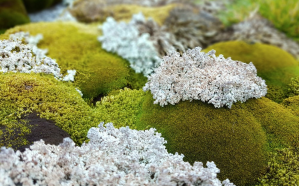 Dr. Natasja van Gestel, Ph.D. and I met at the first annual No-Till Texas Soil Health Symposium in Lubbock last year. Dr. van Gestel is a Quantitative Ecologist at Texas Tech University. Later in the year I participated in the Grower Citizen Science Project with Texas Tech University led by Natasja, studying the soils of farms in this area.
Dr. Natasja van Gestel, Ph.D. and I met at the first annual No-Till Texas Soil Health Symposium in Lubbock last year. Dr. van Gestel is a Quantitative Ecologist at Texas Tech University. Later in the year I participated in the Grower Citizen Science Project with Texas Tech University led by Natasja, studying the soils of farms in this area.
On December 3rd Natasja left Lubbock to participate in a science project in Antarctica. The goal of her project is to learn more about the carbon cycle in very young ecosystems that are rapidly warming. The study area behind the Palmar Research Station was covered by a glacier, but record warming rates (compared to 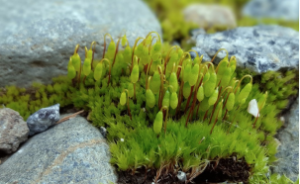 the rest of the planet) caused the glacier to retreat hundreds of meters, thereby exposing soils once again – providing new opportunities for plants and microbes!
the rest of the planet) caused the glacier to retreat hundreds of meters, thereby exposing soils once again – providing new opportunities for plants and microbes!
Today you can follow her adventures in Antarctica in her blog: https://natasjavgestel.github.io/blog/
In a couple of months I hope Natasja will share her photos and findings with Lubbock Master Gardeners Association in person.
Please enjoy these pictures of Antarctica’s beautiful flora.
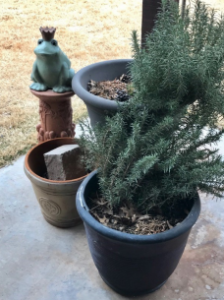 Closer to home, Janis Campbell shared this photo of her rosemary (left), green and vibrant even in winter. Rosemary is a very tough, water wise plant, well suited to the ups and downs of our High Plains weather.
Closer to home, Janis Campbell shared this photo of her rosemary (left), green and vibrant even in winter. Rosemary is a very tough, water wise plant, well suited to the ups and downs of our High Plains weather.
Dotty Woodson Ph.D. was an instructor for my plant propagation and rainwater 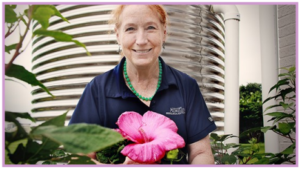 harvest specialist classes. She taught Master Gardener classes in Lubbock and was the keynote speaker for the May 2015 Wolffort Water Expo. She is retiring from Texas A&M Agrilife Extension after a long career as a rainwater harvesting and landscape horticulture specialist. She is leaving big boots to fill.
harvest specialist classes. She taught Master Gardener classes in Lubbock and was the keynote speaker for the May 2015 Wolffort Water Expo. She is retiring from Texas A&M Agrilife Extension after a long career as a rainwater harvesting and landscape horticulture specialist. She is leaving big boots to fill.
Mother Earth News Fair
by Dennis Howard
Last week Penny and I spent the weekend in Belton, Texas attending the Mother Earth News Fair. Mother Earth News sponsors these fairs around the country, tailoring each fair to the region in which it is held.
If you aren’t familiar with Mother Earth News, it is a publication that caters to those with interests in gardening, homesteading, farming and sustainable lifestyles of all sorts. The exhibitors at the fair in Belton ranged from the Ploughshare Institute to Yanmar Power equipment. There were all sorts of displays: chickens, poultry equipment and supplies, goats, pigs, and horses. A wide range of displays in the gardening and farming areas included worm ranching, soil amendments, garden equipment, beekeeping, irrigation, and seed vendors and suppliers.
In addition The Fair offered six different venues on which speakers rotated, presenting on topics ranging
from permaculture design to essential oils.
Penny and I enjoyed browsing the exhibits and displays. We managed to attend presentations on organic
soil regeneration, urban organic gardening practices, essential oils, Texas food forest designs, seed starting, hot pepper production from seed to market, and, my favorite– making mead at home. The downside to the last one was that there were no free samples.
The Texas Master Naturalists and the Texas Native Plant Society both had booths at the Fair and were enjoying lots of visitors. Sadly, the Texas Master Gardeners were not represented except for myself and two other Master Gardeners with whom I connected during the fair.
If you have never attended a Mother Earth News Fair, I would encourage you to consider making the trip to Belton next year. It was a worthwhile and educational trip for both of us, and we brought back a wealth of ideas, knowledge and tips that we hope to share with all of you.
Spring Rose Gardening
by Nell Rains
The High Plains area experiences gardening extremes. We will have periods of cold weather and then days of moderate 60-70 degree temperatures. It is tempting to grab the rose pruners and start pruning, especially when you see the rose buds swelling and breaking.
Just don’t. We often have freezes up to the end of March. Rosarians are advised to wait to begin rose pruning till after you see the Forsythia in bloom. I think this is still good advice.
What we can and should do is examine the bushes for canes that are dead or dying and cut those out. Cut them back to live wood or the ground without leaving stubs that will re-sprout. Sterile alcohol wipes are available and makes sterilizing your pruning equipment much easier in case there is any kind of disease. Pruning tools work best when sharpened. Examine the sprayer to be sure that it is cleaned. I recommend that you have separate sprayers; one for liquid fertilizer, another for chemical weed control and one for insecticide application. Use a product called tank and equipment cleaner and run it through the tank to clean out any spray residue.
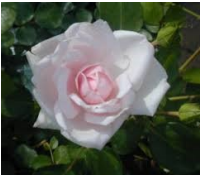 This is a good time of the year to transplant roses. The plants are dormant, or nearly so. When planting a rose into a new spot prepare the new location first. We don’t want the plant to be out of the ground any longer than necessary. Pick a site with 6-8 hours of daily sun. Keep as much soil around the root ball as possible when you dig it up. Enrich the soil generously with compost. If you are planting just a few roses, buying prepared rose soil blend mix is a good way to go. After planting, mound up mulch around the lower part of the bush. Keep the rose watered while it gets established. Do not prune a transplanted rose until it shows you what needs to be removed. Since you are planting into amended soil, it is not necessary to fertilize a newly planted rose until March.
This is a good time of the year to transplant roses. The plants are dormant, or nearly so. When planting a rose into a new spot prepare the new location first. We don’t want the plant to be out of the ground any longer than necessary. Pick a site with 6-8 hours of daily sun. Keep as much soil around the root ball as possible when you dig it up. Enrich the soil generously with compost. If you are planting just a few roses, buying prepared rose soil blend mix is a good way to go. After planting, mound up mulch around the lower part of the bush. Keep the rose watered while it gets established. Do not prune a transplanted rose until it shows you what needs to be removed. Since you are planting into amended soil, it is not necessary to fertilize a newly planted rose until March.
There are a lot of really good landscape roses on the market that do well in low maintenance gardens.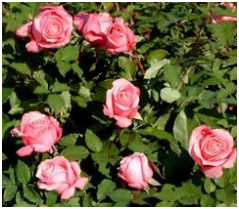 Characteristics such as disease resistance, flowering and plant vigor are important to success with roses. Those characteristics that make the Knock-Out roses so dependable have an opposite effect when the rose is not placed correctly in the landscape. Left to grow naturally, Knock-Out gets 8 feet tall and 6 feet wide. When you plant a rose that matures to this size and put it in a spot that is 3 feet wide something is going to give. The gardener as well as the plant suffers from repeated trimming, fertilizing and watering. This is how to turn a low-maintenance rose into a high- maintenance plant. The key is to select a variety whose mature size is in balance with your garden space.
Characteristics such as disease resistance, flowering and plant vigor are important to success with roses. Those characteristics that make the Knock-Out roses so dependable have an opposite effect when the rose is not placed correctly in the landscape. Left to grow naturally, Knock-Out gets 8 feet tall and 6 feet wide. When you plant a rose that matures to this size and put it in a spot that is 3 feet wide something is going to give. The gardener as well as the plant suffers from repeated trimming, fertilizing and watering. This is how to turn a low-maintenance rose into a high- maintenance plant. The key is to select a variety whose mature size is in balance with your garden space.
Susan-Williams Ellis
by Jean Anne Stratton
Susan Williams-Ellis (1918-2007) was an English pottery designer, who was best known for co-founding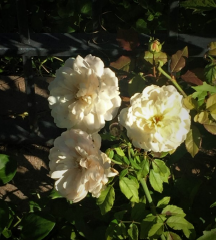 Portmeirion Pottery. My Susan Williams-Ellis rose selection was inspired by my fondness for her pottery designs, Botanic Garden. Last spring I planted a David Austin Rose named Susan Williams- Ellis; a delightful, unassuming little rose of typical Old Rose beauty. This rose is a pure white sport of the pink English Rose, ‘The Mayflower’ with a strong old rose fragrance and exceptionally long flowering season. Susan was a great enthusiast of the English Roses and painted some beautiful water colors of them.
Portmeirion Pottery. My Susan Williams-Ellis rose selection was inspired by my fondness for her pottery designs, Botanic Garden. Last spring I planted a David Austin Rose named Susan Williams- Ellis; a delightful, unassuming little rose of typical Old Rose beauty. This rose is a pure white sport of the pink English Rose, ‘The Mayflower’ with a strong old rose fragrance and exceptionally long flowering season. Susan was a great enthusiast of the English Roses and painted some beautiful water colors of them.
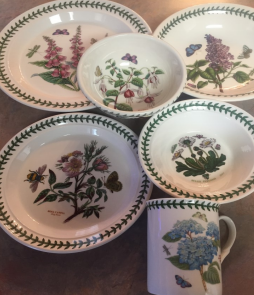 Susan Williams-Ellis said: “I remember when we first launched Botanic Garden. At that time, you might have had dessert sets which had different patterns on each plate, but for the traditional tableware setting, everything had to match. I thought: ‘Why can’t we have different patterns all within one collection? The department store buyers in 1972 said no-one would stock it as there were too many designs – and no-one would want to buy it as it didn’t match. I think I proved them all wrong!”
Susan Williams-Ellis said: “I remember when we first launched Botanic Garden. At that time, you might have had dessert sets which had different patterns on each plate, but for the traditional tableware setting, everything had to match. I thought: ‘Why can’t we have different patterns all within one collection? The department store buyers in 1972 said no-one would stock it as there were too many designs – and no-one would want to buy it as it didn’t match. I think I proved them all wrong!”
Blossom by blossom
the Spring begins.Algernon Charles Swinburne